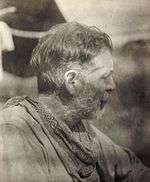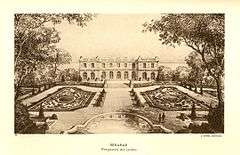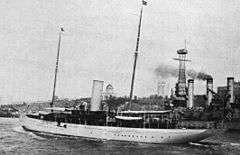Alexander H. Rice, Jr.
| Alexander Hamilton Rice, Jr. | |
|---|---|
 Rice in the field | |
| Born |
August 2, 1875 Boston, Massachusetts |
| Died |
July 21, 1956 (aged 80) Newport, Rhode Island, United States |
| Residence | Newport, Rhode Island |
| Nationality | American |
| Fields | Geography |
| Institutions | Harvard University |
| Alma mater | Harvard University |
| Known for | aerial mapping and Amazon River exploration |
| Notable awards | Commandeur de la Légion d'honneur |
| Spouse | Eleanor Elkins Widener (m. 1915) |
Alexander Hamilton Rice, Jr. (August 29, 1875 – July 21, 1956) was an American physician, geographer, geologist and explorer especially noted for his expeditions to the Amazon Basin. He was professor of geography at Harvard University from 1929 to 1952, and was the founder and director of the Harvard Institute of Geographical Exploration.[1]
Early life and military service
Rice's grandfather was former Boston mayor, Massachusetts governor and US Congressman Alexander Hamilton Rice. After attending the Noble and Greenough School he earned an A.B. from Harvard College (1898) and an M.D. from Harvard Medical School (1904).[2] In 1915, he married widowed RMS Titanic survivor Eleanor Elkins Widener.
In 1914–15 he volunteered for the Paris surgical staff of the Ambulance Américain, a group of American civilian doctors serving in Europe prior to the United States' entry into World War I. From 1915 to 1917 he directed the Hôpital 72, Société de Secours aux Blessés Militaires, a French charity hospital also in Paris. On the United States' 1917 entry into the war, he was commissioned as a lieutenant in the United States Naval Reserve, directing the 2nd Naval District Training School for Reserve Officers at Newport, Rhode Island, where he served until 1919.[3][4] In 1919, he was awarded the Commandeur de la Légion d'honneur for his service to the people of France.
In 1922 Rice was the unsuccessful Republican nominee for US Congress from the Massachusetts 12th Congressional District.[5]
Exploration and academic career



As a geographer and explorer Rice specialized in rivers.[1][7] On seven expeditions, beginning in 1907, he explored 500,000 square miles (1,300,000 km2) of the Amazon Basin,[7] mapping a number of previously unknown rivers in the northwestern area of the Amazon Basin reaching into Columbia and Venezuela.
After his 1915 marriage, his socialite wife accompanied him on several expeditions to South America which were chronicled in the geographic literature and followed closely by the popular press. A 1916 expedition was the subject of a 1918 book by a colleague, William Thomas Councilman.[8] During a 1920 trip, it was reported that "the party warded off an attack by savages and killed two cannibals"[9]—
In 1924–25 during one his most important expeditions from the standpoint of scientific discovery, he ascended the Orinoco River to its headwaters, traversed the natural Casiquiare canal, and descended the Rio Branco to the Amazon at Manaus.[1] This was the first expedition to use aerial photography and shortwave radio for mapping.[12] He also established hospitals for Indians in Brazil, researched tropical diseases, and conducted expeditions in Alaska and Hudson Bay.[13]
His explorations of the Amazon and Orinoco Rivers won him honors which included: Gold Medalist, Philadelphia Geographical Society; Gold Medalist, Société Royale de Géographie d'Anvers; and Gold Medalist, Harvard Travelers Club.[14] He led his last expedition in 1924–1925.[15]
In 1929 Rice founded Harvard's Institute of Geographical Exploration, to which he and his wife provided a considerable endowment, and which under Rice's directorship became an important center for the science of photogrammetry. Rice's other positions included Curatorship of the South American Section of the Peabody Museum of Archaeology and Ethnology; Lecturer in Diseases of Tropical South America at Harvard Medical School; and Trustee of the American Museum of Natural History. He belonged to the Rhode Island Society of Colonial Wars, and the Society of the Cincinnati.[14]
When the Institute closed in 1952, Rice retired to Miramar,[16] his wife's family mansion in Newport, Rhode Island, where he died in 1956.
Genealogy
Alexander H. Rice, Jr. was a descendant of Edmund Rice, an English immigrant to Massachusetts Bay Colony, as follows:[17]
- Alexander Hamilton Rice, Jr., son of
- John Hamilton Rice (1849–1899), son of
- Alexander Hamilton Rice (1818–1895), son of
- Thomas Rice (1782 – c. 1859), son of
- John Rice (1751–1808),[18] son of
- Elijah Rice (b. 1728), son of
- William Rice (c. 1700 – 1769), son of
- Edmund Rice (1653–1719), son of
- Edward Rice (1622–1712), son of
- Edmund Rice (1594–1663)
References
| Wikimedia Commons has media related to Alexander H. Rice, Jr.. |
- 1 2 3 "A Nod to Ham Rice", Harvard Magazine, March 1999.
- ↑ "Harvard Class of 1898 Report 2". Harvard University. 1907. Retrieved 3 September 2011.
- ↑ p.799 In: Frederick Sumner Mead (ed.) 1921. Harvard's Military Record in the World War. Harvard University Press, Cambridge, Massachusetts.
- ↑ "Alexander Hamilton Rice, Jr. Biographical Summary". Roots Web. Retrieved 27 April 2009.
- ↑ "U.S. Representatives from Massachusetts (1920s)". The Political Graveyard (politicalgraveyard.com). Retrieved 11 Oct 2009.
- ↑ "The 'Alberta' leaving New York for the Amazon River", Pan American Notes, Bulletin of the Pan American Union 43 (6), Dec 1916, p. 778
- 1 2 "Attacked by Wild Indians". New York Times. May 1, 1920. Retrieved 15 March 2011.
- ↑ Councilman, William Thomas; Lambert, R.A., The medical report of the Rice expedition to Brazil, Harvard University Press, 1918
- ↑ "Mrs. A.H. Rice Dies in a Paris Store – New York and Newport Society Woman, Wife of Explorer, Noted for Philanthropy – A Survivor of Titanic – Lost First Husband and Son in Disaster – Gave Library to Harvard University", New York Times, July 14, 1937
- ↑ "Explorers Kill Cannibals – Former Mrs. Widener Shares Perils in South America", New York Tribune, May 1, 1920, p. 7
- ↑ Plotkin, Mark J. (March–April 2013), "Alexander Hamilton Rice: Brief life of an Amazon explorer: 1875–1956", Harvard Magazine (Harvard University)
- ↑ Tenner, Edward. 1988. "Harvard, Bring Back Geography!" Harvard Magazine May–June 1988
- ↑ "ALEXANDER RICE, EXPLORER, WAS 80", The New York Times, 24 July 1956
- 1 2 "Alexander Hamilton Rice, Jr.". Rootsweb. Retrieved 20 Oct 2015.
- ↑ "'Tabloid' medicine chest used on Dr Hamilton Rice's Amazonian Expedition in 1919, England, 1900–1919", Science Museum, London
- ↑ Kahn, Joseph P. (October 1, 2006). "Gilded Age opportunity: Ornate Newport mansion placed on the auction block". Boston Globe. Archived from the original on 25 March 2009. Retrieved 27 April 2009.
- ↑ Edmund Rice (1638) Association, 2011. Descendants of Edmund Rice: The First Nine Generations.
- ↑ "John Rice (1751-1808)". Edmund Rice (1638) Association. Retrieved 28 Sep 2014.